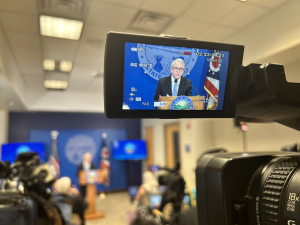News
Ohio governor blasts redistricting on fall ballot, urges lawmakers to make changes next year
By: Jo Ingles | Karen Kasler | Statehouse News Bureau
Posted on:
COLUMBUS, Ohio (Statehouse News Bureau) — Gov. Mike DeWine is blasting a redistricting proposal that will be on the November ballot. The Citizens Not Politicians plan before voters this fall would create a new system to draw legislators’ district lines and eliminate the Ohio Redistricting Commission, which includes the governor among its seven members. DeWine is promising voters that if they reject this plan, he will work with Ohio lawmakers next year to come up with a better method for redistricting.

“One of the reasons that voters will be unhappy with the maps that the amendment will produce is that the fall ballot proposal will make proportionality, it makes it king. Proportionality under this constitutional amendment must supersede everything else,” DeWine said.
DeWine said if the redistricting issue passes, it “will directly result in the worst gerrymandering we have ever seen.” And DeWine said if voters turn back the November ballot issue, he will ask lawmakers to come up with a different plan similar to the one used in Iowa. He said that one uses a panel similar to the Ohio Legislative Service Commission, the body that drafts bills for lawmakers. And DeWine said the addresses of politicians and political leanings of voters in districts cannot be used to draw those line. But DeWine wouldn’t work on that new plan with lawmakers until the next General Assembly is seated after the first of the year.
Citizens Not Politicians Spokesman Chris Davey isn’t buying DeWine’s suggestions.
“Governor DeWine is a good guy and a distinguished political servant but he’s horribly misinformed on this amendment,” Davey said.
Davey said former Ohio Supreme Court Chief Justice Maureen O’Connor, who helped write the Citizens Not Politicians amendment, will be reaching out to the governor to explain proportionality is not “king” as DeWine told reporters. Davey said the plan on the ballot tries to keep communities together as one of its main tenants.
“Districts must be geographically contiguous, they must comply with the United States Constitution and they must comply with the Voting Rights Act,” Davey said.
Davey said the current maps don’t keep communities together and notes two school buildings within the same Northeast Ohio school districts are in two separate congressional districts. Davey said the Iowa plan that DeWine recommended would keep politicians in charge of the process. That’s a problem he said, noting that seven times, lawmakers passed maps that were ruled unconstitutional. O’Connor was leading the Ohio Supreme Court during that time when the maps were rejected. She was the lone Republican to vote against the maps each time they were presented in 2021 and 2022. Davey said he doesn’t think Ohioans will trust DeWine and Ohio’s political leaders anymore when it comes to redistricting.
“It was the politicians that wrote those amendments. And the voters in good faith thought that they would fix the problem, and they didn’t. And the reason that they didn’t is because politicians continued to be in charge,” Davey said.
The Citizens Not Politicians issue was approved for the fall ballot a week ago, after organizers turned in 535,005 valid signatures. The plan would cut politicians and lobbyists out of the redistricting process and put a 15-member citizen panel in charge of drawing district lines. That 15-member panel would be composed of an equal number of Republicans, Democrats, and independents selected through a detailed process.
The maps currently being used were allowed by a federal court for this year’s elections. In this map, Republicans increased their supermajority in the 99-member House from 64 seats to 67, and in the 33-member Senate from 25 seats to 26. The map for Ohio’s 15-member congressional delegation was expected to result in the election of 12 Republicans and three Democrats, but the final result was 10 Republicans and five Democrats. And while the two Democrats on the commission eventually voted to pass the maps, both have said they were not happy with the outcome and only voted that way to prevent even worse maps from being adopted.
In Iowa, redistricting is done by state lawmakers but with heavy input from the state’s nonpartisan legislative services agency and a bipartisan advisory committee. State law states that individual counties cannot be split up into multiple legislative or congressional districts, and partisan favoritism can’t be considered. Maps must be approved by Sept. 15, or the Iowa Supreme Court will draw the maps.
The next step for the Citizens Not Politicians amendment is for the Ohio Ballot Board, which is controlled by Republicans, to determine the language voters will see on the ballot when they go to the polls in November. That panel is expected to meet later this month.

